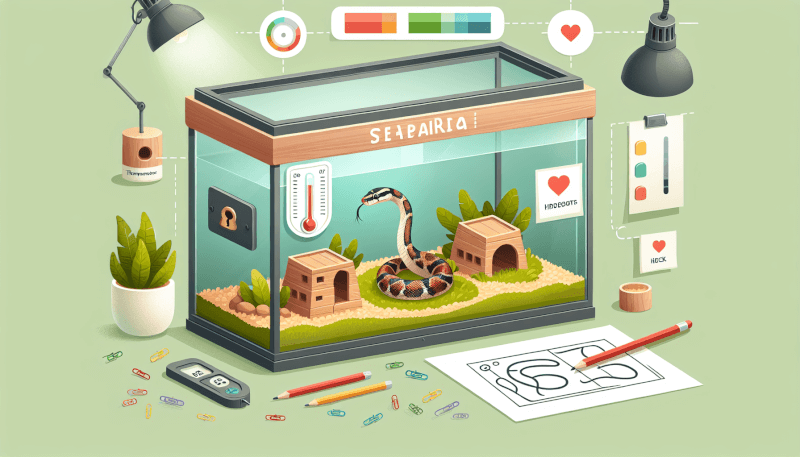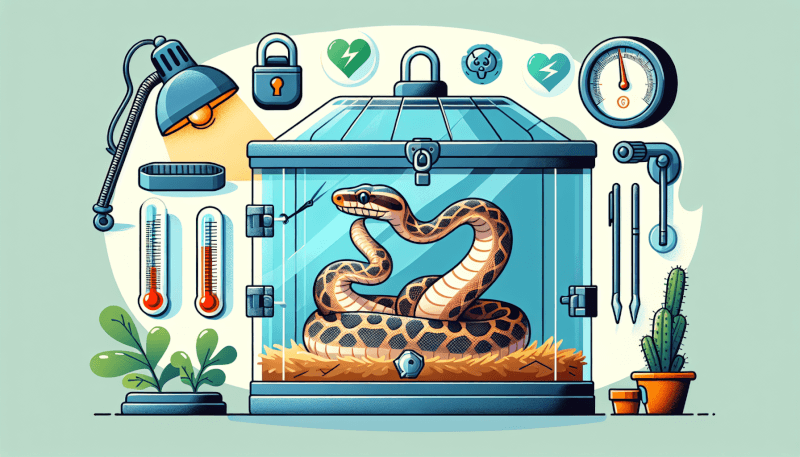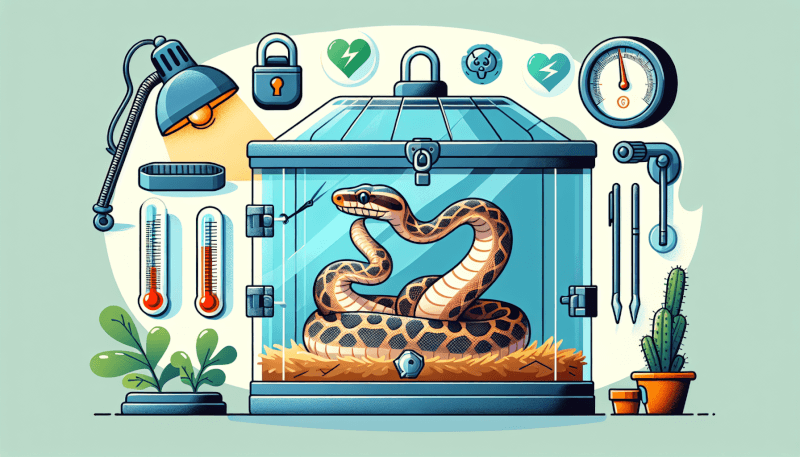Imagine owning a pet snake – an exotic and fascinating creature that requires special care. Ensuring the safety and well-being of your slithery friend is of utmost importance, but where do you start? In this article, we will explore the essential tools that every snake owner must have in order to maintain a safe environment for their scaly companion. From proper housing to temperature regulation, these tools are crucial in creating a comfortable and secure space for your pet snake. So, let’s embark on a journey to become a responsible and informed snake owner, equipped with the necessary tools to provide the best care possible.
Enclosure
When setting up an enclosure for your pet snake, it’s essential to consider the appropriate size. Snakes require enough space to move around comfortably, so choose a tank or terrarium that allows for adequate movement. A general guideline is to provide a enclosure that is at least the length of the snake’s body, but double the length is preferable. This will ensure that your snake has ample room to stretch out and explore its surroundings.
Another important aspect of the enclosure is a secure lid. Snakes are notorious escape artists, and you wouldn’t want your pet slithering around your house unsupervised. A tight-fitting lid is essential to prevent any Houdini-like escape attempts. Additionally, make sure the lid has locks or fasteners that can withstand the strength of your snake, as some species can be quite powerful.
Proper ventilation is also crucial for a healthy and safe snake enclosure. Adequate airflow helps maintain a healthy environment, prevents the build-up of moisture and mold, and promotes good respiratory health for your pet. Ensure that your enclosure has sufficient ventilation holes or a mesh top to allow for proper air circulation.
Lastly, an escape-proof enclosure is a must. Snakes are experts at finding small gaps and squeezing through them. To prevent any potential escape, it’s essential to check the enclosure thoroughly for any openings or gaps. Seal off any holes or crevices that your snake might exploit. Remember, it’s better to be safe than sorry when it comes to securing your snake’s living space.
Keeping your snake’s enclosure clean is vital for its overall health and well-being. Choose an enclosure that is easy to clean and maintain. Look for enclosures that have removable parts or easy access for cleaning purposes. A clean and hygienic environment will minimize the risk of any infections or illnesses for your snake.
Heating and Lighting
Snakes are ectotherms, meaning they rely on external heat sources to regulate their body temperature. When creating a safe environment for your pet snake, it’s essential to provide a proper heat source. This can be achieved through various means, such as heat mats, heat lamps, or ceramic heaters. Ensure that the heat source is placed in a way that allows your snake to bask and regulate its body temperature effectively.
To monitor the temperature within the enclosure, a thermometer is a must-have tool. It allows you to keep track of the temperature gradient in the habitat, ensuring that your snake has access to both warm and cool areas. The ideal temperature gradient for most snakes is a warm side ranging from 85-90°F (29-32°C) and a cooler side around 75-80°F (24-27°C). By maintaining the correct temperature range, you are providing your snake with the optimal conditions for digestion, shedding, and overall well-being.
In addition to heat, snakes also require UVB lighting. UVB lighting helps reptiles produce Vitamin D3, which is crucial for calcium absorption and proper bone development. When selecting UVB lighting for your snake’s enclosure, choose a bulb specifically designed for reptiles. Place the UVB light within a safe distance from your snake, ensuring it receives the necessary exposure without any risk of burns or damage.

Substrate
Choosing the right substrate for your snake’s enclosure is essential for its comfort and well-being. The substrate serves multiple purposes, including providing a natural and aesthetically pleasing environment, retaining humidity, and facilitating easy cleaning.
When selecting a substrate, always prioritize safety and avoid substrates that could pose harm to your snake if ingested accidentally. Opt for non-toxic materials such as reptile-safe bark, coconut coir (also known as coconut husk fiber), or reptile-specific mulch. These substrates provide a natural appearance and are safe for your snake to burrow or explore.
Retaining humidity is crucial for many snake species, as it helps with shedding and overall hydration. Some substrates, such as coconut coir or reptile-specific mulch, are excellent at retaining moisture, providing a stable humidity level within the enclosure. Maintaining the proper humidity level is key to preventing skin issues and ensuring your snake’s respiratory health.
Easy cleaning is another factor to consider when choosing the substrate. Select a substrate that can be easily spot-cleaned, and if necessary, completely replaced during regular enclosure maintenance. Avoid substrates that can become easily soiled, as they can lead to bacteria growth and unpleasant odors.
Hideouts
Snakes are known for their solitary nature and require a sense of security in their enclosure. Providing multiple hiding spots is crucial for your snake’s well-being. Hiding spots mimic natural hiding places in the wild and provide a safe retreat for your snake when it feels stressed or threatened.
Offer hiding spots of different sizes and shapes to accommodate snakes of various sizes and species. Small plastic or wooden caves, hollow logs, or commercially available reptile hides are excellent options. Choose hideouts that are secure and stable, ensuring they won’t collapse or shift around when your snake is using them.
Easy access to hiding spots is important to prevent any stress or injury for your snake. Avoid hideouts with narrow entrances that may cause your snake to struggle or get stuck. Opt for hideouts that have openings large enough for your snake to comfortably enter and exit.
By providing multiple hideouts, you are creating a diverse environment that allows your snake to exhibit its natural behaviors, promotes mental well-being, and reduces stress levels.
Water Bowl
A sturdy and tip-proof water bowl is essential to provide your snake with constant access to fresh drinking water. Choose a bowl that is appropriate in size, allowing your snake to fully submerge if desired. A larger water bowl allows for soaking and helps with hydration.
Regularly clean the water bowl and ensure that it is always filled with fresh, clean water. Snakes often use their water bowls to regulate their hydration levels, bathe, and aid in shedding. By providing a consistent source of clean water, you are ensuring your snake’s overall health and well-being.
The water bowl should be easily accessible for your snake. Place it in a location within the enclosure where your snake can easily find and access it without any obstructions. Consider the size of your snake and its ability to reach the water bowl comfortably.
Thermometer and Hygrometer
Accurate temperature monitoring is crucial to maintain the proper heat gradient within your snake’s enclosure. A reptile-specific thermometer allows you to monitor temperature levels effectively and adjust the heat source if necessary. Opt for an easy-to-read thermometer with a reliable and durable design.
In addition to temperature, monitoring the humidity level within the enclosure is equally important. A hygrometer measures the humidity percentage and helps you maintain the ideal range for your specific snake species. Aim for a humidity range that suits your snake’s natural habitat and individual needs.
Choose a hygrometer with an easy-to-read display and one that provides accurate and consistent readings. Remember to place the thermometer and hygrometer in a location within the enclosure that accurately represents the overall conditions.

Feeding Tools
Feeding tongs are an essential tool for safely and hygienically offering food to your snake. They help you maintain a safe distance between your hand and your snake’s mouth, preventing accidental bites or injuries. Choose tongs that are appropriate in length and comfortable to grip.
Having a separate enclosure for feeding your snake is important to avoid associating your presence with food. This helps reduce stress and promotes a healthy feeding response. Use a feeding container that is suitable for the size of your snake and easy to clean.
Cleaning supplies are essential for maintaining a safe and sanitary feeding routine. Make sure to have suitable disinfectants for cleaning the feeding container and any utensils used. Brushes specifically designed for cleaning reptile equipment are handy for keeping everything hygienic. Disposable gloves can also be used to minimize any potential contamination.
Locks and Security
When it comes to ensuring the safety of your pet snake, locks and security measures are paramount. Choose reptile-safe locks for your snake’s enclosure to prevent any accidental opening by curious pets or unauthorized individuals. Locks add an extra layer of security and peace of mind.
Secure cage fasteners are equally important in preventing any unwanted escapes. Ensure that the enclosure has sturdy and reliable latches or fasteners that are snake-proof. Regularly check these fasteners to ensure they are in good working condition and not susceptible to wear and tear.
A secure lid is crucial to preventing any escape attempts by your snake. Make sure the lid fits tightly and securely on the enclosure, leaving no gaps or openings. Additionally, consider using child-proof mechanisms if there are young children or visitors who may inadvertently open the enclosure.

Cleaning Supplies
Maintaining a clean and hygienic environment for your snake is essential for its overall health and well-being. Safe disinfectants are necessary for cleaning the enclosure and any accessories. Choose disinfectants specifically formulated for reptile enclosures to ensure they are safe for your snake.
Cleaning brushes are invaluable tools for removing any debris or waste from the enclosure. Brushes specifically designed for reptile enclosures are available and make cleaning more efficient. Use disposable gloves while cleaning to protect yourself from potential pathogens.
Paper towels or reptile-safe bedding are useful for spot cleaning or lining the enclosure. They absorb moisture and waste, making cleaning easier. Use bedding appropriate for your snake species, ensuring it is non-toxic and doesn’t present a choking hazard.
Terrarium Decorations
Terrarium decorations not only enhance the aesthetic appeal of your snake’s enclosure but also provide enriching experiences for your snake. Climbing branches or driftwood give your snake opportunities to explore and exercise. Ensure the branches are sturdy and securely placed to prevent any potential injuries.
Artificial plants offer a natural-looking environment and can provide additional hiding spots or climbing opportunities. Choose plants specifically designed for reptile habitats, avoiding any toxic or sharp plants that may harm your snake.
Hides or caves are an essential part of your snake’s enclosure. Offer a variety of hideouts in different sizes and shapes to cater to your snake’s preferences. Natural-looking hides made from reptile-safe materials are widely available. Ensure the hides are stable and won’t collapse when your snake is using them.
Enrichment items, such as puzzle feeders or interactive toys, can provide mental stimulation for your snake. These items help prevent boredom and encourage natural behaviors. Consider your snake’s species and individual preferences when selecting enrichment items.
By providing a stimulating and enriched environment, you are promoting the overall well-being and happiness of your pet snake.
In conclusion, maintaining a safe environment for your pet snake requires a variety of essential tools. From the appropriate enclosure size and secure lid to the right heating and lighting setup, each component plays a crucial role in ensuring your snake’s comfort and well-being. Selecting a safe and non-toxic substrate, providing multiple hideouts, and offering a sturdy and appropriately sized water bowl are also vital for your snake’s health. Thermometers and hygrometers help you monitor and maintain optimal temperature and humidity levels, while feeding tools and locks add an extra layer of security. Regular cleaning with safe disinfectants and appropriate cleaning supplies prevents infections and promotes a hygienic environment. Finally, terrarium decorations, such as climbing branches, artificial plants, hides, and enrichment items, create a stimulating and natural environment for your pet snake. By implementing these essential tools, you can create a safe, comfortable, and enriching habitat that will enhance the well-being of your pet snake and allow it to thrive.


